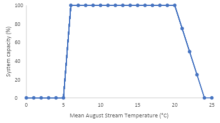Temperature and Plains Sucker System Capacity
mbakken
View all records in the stressor response library
Species Common Name
Plains Sucker
Latin Name (Genus species)
Pantosteus jordani
Stressor Name
Temperature
Specific Stressor Metric
Mean August Stream Temperature
Stressor Units
°C
Vital Rate (Process)
Occupancy (transformed to survival)
Geography
Saskatchewan
Detailed SR Function Description
This temperature SR curve defines the relationship between maximum annual stream temperature (MAST; °C) and percent system capacity. Stream temperatures are highly variable within and among watersheds and streams, with maximum temperatures ranging from 10.15°C-39.74°C in the Milk River drainage (usually in August or September; unpublished data). Lethal maximum temperatures in laboratory experiments can get up to 34°C [Schultz and Bertrand 2011]) and experimental agitation temperatures ranged from 9.17°C-31.16°C, though tolerance was influenced by body size (fish were from the Milk River drainage; unpublished data). Therefore, this SR function was derived using a combination of available field and experimental data. Maximum stream temperature was used for this SR function because we had data on upper thermal limits (agitation temperature) for Plains Sucker; however, it should be noted that this temperature SR function could be adjusted to represent the mean annual stream temperature as the independent variable but the stressor magnitude data must be also reported as mean annual stream temperature.
Function Derivation
Based on data from Plains Sucker; Landscape correlation; Unpublished; manipulation; Expert opinion
Transferability of Function
This stressor-response function is suitable for use on Plains Sucker populations in the Saskatchewan-Nelson and Missouri River drainages in Southern Alberta and Saskatchewan. It should be noted that the thermal tolerance literature tends to assume different populations of the same species have similar physiological thresholds to temperature (Hasnain et al. 2010); however, this assumption hasn’t been specifically studied for Plains Sucker. Similarly, it may be reasonable to assume that the SR function can be applied to Cordilleran Sucker, given the similarity of their physical characteristics (prior to 2023 both species were classified under a single species, Mountain Sucker); however, there is no data to confirm this assumption. Further, Plains Sucker from the Black Hills reportedly have an upper thermal tolerance of 32.9°C-34°C (Schultz and Bertrand 2011), which is within the range reported for other catostomid species (30.7°C-37.2°C, Hasnain et al. 2010). However, given the range of preferred temperatures, caution should be taken when using this function on other catostomids, and it might be more advisable to gauge transferability based on thermal guild (e.g. temperature stressor-response functions for other cool-water species) rather than family.
Source of stressor Data
Practical application of the SR function necessitates that users obtain estimates of stressor magnitude (level) in the target system. We have data for stream temperature for XX sites within the Milk River drainage; however, these data are not yet published.
Function Type
continuous
Stressor Scale
linear
References Cited
Jarvis, L. 2022. Temperature stressor-response function for Plains Sucker. Department of Fisheries and Oceans CEMPRA model for Plains Sucker.
Jarvis, L. 2022. Cumulative Effects Model for Prioritizing Recovery Actions (CEMPRA): Plains Sucker case study.
Schultz, L.D. and K.N. Bertrand. 2011. An assessment of the lethal thermal maxima for Mountain Sucker. Western North American Naturalist 71(3).
Jarvis, L. 2022. Cumulative Effects Model for Prioritizing Recovery Actions (CEMPRA): Plains Sucker case study.
Schultz, L.D. and K.N. Bertrand. 2011. An assessment of the lethal thermal maxima for Mountain Sucker. Western North American Naturalist 71(3).
File Upload
Stressor Response Chart

